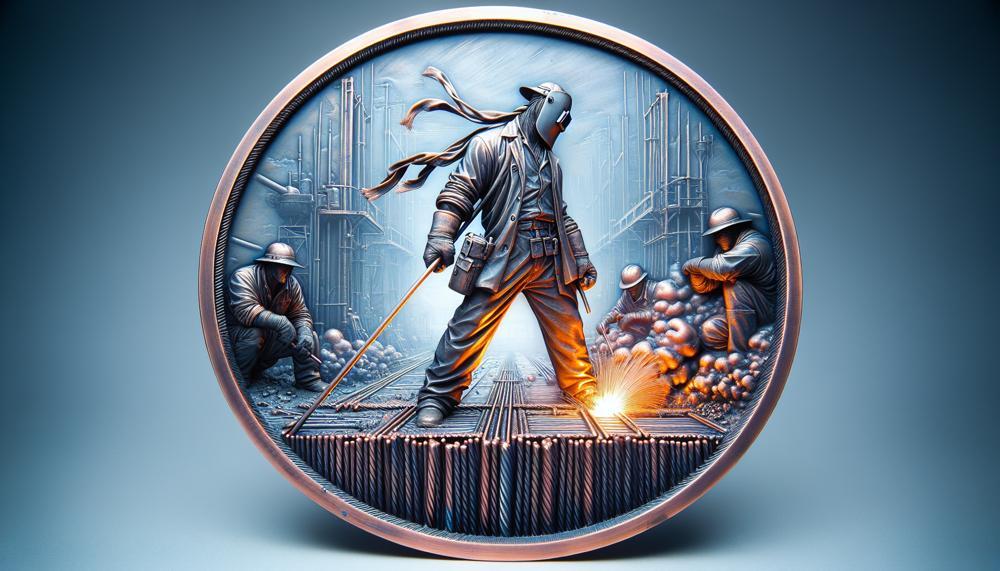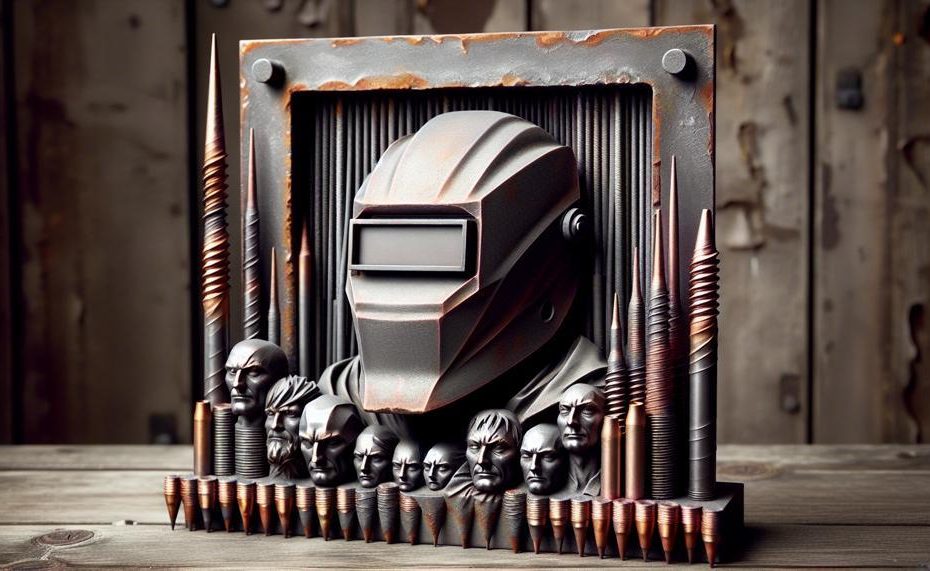Are you a welding enthusiast looking to expand your skills and take on new challenges? Do you find yourself struggling to choose the right type of rod for your welding projects? You’re not alone. Welding is an exciting craft, but it also comes with its fair share of difficulties. And one of the most common struggles welders face is working with different types of rods.
In this blog post, we’ll delve into the world of welding rods and explore the question: what is the most challenging welding rod to work with? There’s a lot to consider when selecting a welding rod. You need to understand their composition and master their behavior under various conditions.
Get ready to gear up and discover:
- The various types of welding rods and their unique properties
- How to choose the right rod for your project
- Common mistakes welders make when using different rods
- Tips and tricks for successful welding with challenging rods
By the end of this post, you’ll understand welding rods. You’ll have the knowledge to tackle any project.
So, let’s dive in and uncover the secrets behind working with difficult welding rods.
Contents
- 1 Common Welding Electrodes
- 2 Different Types of Welding Rods
- 3 What Is the Hardest Rod of Weld With?
- 4 Welding Rod Number Explanation
- 5 Common Welding Rods and Their Uses
- 6 How to Choose a Welding Rod Type
- 7 Pick the Correct Size of Welding Rod
- 7.1 Step 1: Measure the thickness of the base metal
- 7.2 Step 2: Select a suitable diameter for the welding rod
- 7.3 Step 3: Consider the type of welding process
- 7.4 Step 4: Understand the amperage range and penetration
- 7.5 Step 5: Compare various types of electrodes
- 7.6 Step 6: Consider the position of the weld
- 7.7 Step 7: Start with a middle amperage and adjust accordingly
- 8 Conclusion
Common Welding Electrodes
There are a variety of commonly used welding electrodes, including E6010, E7018, E6013, E308L-16, and E309L-1. The most challenging one to weld with is the E7018 electrode. This is because it has strict storage requirements and is sensitive to moisture. It also has a low deposition rate and requires precise control and specialized techniques.
The E7018 electrode is known for its exceptional strength and durability. This makes it a preferred choice for heavy-duty welding projects. However, its high demands can make it a difficult electrode to work with for beginners.
Proper storage and moisture control are crucial for this electrode as any exposure to moisture can result in porosity and weak welds.
Furthermore, this electrode has a low deposition rate. This means it takes more time and effort to complete a weld compared to other electrodes. This can be a significant challenge for welders who are working on tight deadlines or have large projects to complete.
The welding techniques required for the E7018 electrode are more complex and require precise control. This can be intimidating for novice welders who are still mastering basic welding techniques. It takes patience, skill, and experience to control the arc and maintain a steady flow of molten metal.
Different Types of Welding Rods
There are four primary types of welding rods: bare electrodes, light coated electrodes, cellulose electrodes, and rutile electrodes. Each type has its own distinct characteristics and purposes in the welding process. All four types have challenges. The cellulose electrode is the most challenging one.
- Bare electrodes are made of pure metal and are mainly utilized for welding steel.
- Light coated electrodes have a thin layer of metal powders and are commonly used for welding mild steel.
- Cellulose electrodes have a thick coating of cellulose material and are typically used for vertical down welding positions.
- Rutile electrodes have a coating of titanium dioxide and are frequently used for welding stainless steel.
What Is the Hardest Rod of Weld With?
The cellulose electrode is notorious for being the most difficult to weld with due to its thick coating and deep penetration abilities. This type of rod demands precise control of the arc to avoid excessive slag and spatter. It also requires a specific welding technique known as “whipping.””
It is also less forgiving when it comes to joint fit-up and cleanliness, making it a challenge for novice welders.
Aside from these four main types, there are also specialty welding rods that require specialized knowledge and skills to be used proficiently. These include iron powder electrodes, nickel alloy electrodes, and tungsten electrodes.
Welding Rod Number Explanation
The numerical markings on welding rods contain vital information. They show the type of metal, recommended use, tensile strength, and operating temperature. These numbers play a significant role in determining the difficulty level of welding. Welding each metal and composition requires different techniques and levels of expertise for efficiency.
To select the appropriate welding rod for a specific job, it is essential to understand the numbers stamped on it.
- The first number indicates the minimum tensile strength of the rod in pounds per square inch. This number is critical in determining the weld’s strength and weight-bearing capacity. For instance, materials with higher durability such as high carbon steel would require a higher tensile strength, while less durable materials may only need a lower one.
- The second number on a welding rod represents the percentage of elongation, which measures the material’s stretchability before breaking. This number is crucial in determining the flexibility and ductility of the welded joint. Materials that are more pliable, such as aluminum, may require a higher percentage of elongation, while sturdier materials like stainless steel may only need a lower percentage.
- The third number on a welding rod specifies the highest operating temperature in degrees Fahrenheit. This is a critical factor to consider when working with heat-sensitive materials as exceeding this temperature can result in damage or weaken the weld.
- Apart from these main numbers, there may also be other stamped numbers on welding rods that describe important properties such as welding position, flux composition, and polarity. These factors also significantly impact the welding difficulty level as they dictate how the material will behave during the welding process.
Common Welding Rods and Their Uses

When it comes to welding, there are various rod types. Each has unique properties and uses.
Here, we’ll discuss some of the most common welding rods and their specific uses.
6010 Electrodes:
These electrodes are perfect for deep penetration on thicker metals. They are the go-to choice for welding professionals.
They can be used on both alternating and direct currents and are suitable for vertical and overhead welding positions.
6011 Electrodes:
Similar to 6010 electrodes, these can also be used on alternating or direct current.
However, they are more versatile and can be used for a wider range of welding positions, including flat, vertical, horizontal, and overhead.
7018 Electrodes:
Known as general-purpose welding rods, these are suitable for use on any type of metal.
They produce a soft arc with minimal splatter, making them an ideal choice for beginners or those who prefer a smoother weld.
7024 Electrodes:
Primarily used for low to moderate carbon steel welding, these electrodes contain a high concentration of iron powder which helps increase welding speed.
They also produce minimal spatter and create a flat bead profile.
Coated Welding Rods:
These welding rods have a flux coating. It provides protection against atmospheric contaminants while the weld cools down.
They are commonly used for welding steel and stainless steel.
Solid Welding Rods:
Solid welding rods do not have any flux coating and require a shielding gas to protect the weld from atmospheric contaminants.
They are typically used for MIG (metal inert gas) or TIG (tungsten inert gas) welding.
Flux Cored Welding Rods:
Similar to coated welding rods, these have a flux coating that protects the weld from atmospheric contaminants.
However, they also have a hollow core that is filled with flux, making them suitable for both MIG and TIG welding.
Metal Cored Welding Rods:
These welding rods have a metal core with flux embedded in it, making them ideal for welding thick materials.
They produce less spatter and can be used for both MIG and TIG welding.
| Welding Rod Type | Specific Uses |
|---|---|
| 6010 Electrodes | Perfect for deep penetration on thicker metals, suitable for vertical and overhead welding positions |
| 6011 Electrodes | Versatile, suitable for various welding positions on different metals |
| 7018 Electrodes | General-purpose welding rod, produces a soft arc with minimal splatter |
How to Choose a Welding Rod Type
How to Choose a Welding Rod Type:
| Factors to Consider When Choosing a Welding Rod Type | Description |
|---|---|
| The Material Being Welded | Choosing the right welding rod is crucial as different materials require different types of electrodes to ensure proper fusion and strength. Matching the composition of the welding rod to the material being welded is essential for a successful weld. |
| The Welding Process | Each welding process has its specific requirements and may need a different type of electrode. Understanding the capabilities and limitations of each process is crucial in selecting the right welding rod type. |
| The Desired Outcome | Different welding rods have unique properties that can affect the strength, appearance, and ease of use for a particular project. The thickness of the material being welded also plays a role in determining which type of rod to use. |
Pick the Correct Size of Welding Rod
Choosing the appropriate size of welding rod for your project can be a complex process, with several factors to consider. This includes the thickness of the base metal, the welding process being used, and the desired result.
To help you navigate through this process, here is a step-by-step guide on how to pick the correct size of welding rod:
Step 1: Measure the thickness of the base metal
The first step in determining the ideal welding rod size is to measure the thickness of the base metal.
This will give you an idea of the range of electrode diameters that will work for your project.
Step 2: Select a suitable diameter for the welding rod
As a general rule, the welding rod should be thinner than the base metal, but not thinner than half of its thickness.
For instance, if your base metal is ¼ inch thick, then a 3/32 inch welding rod would be appropriate. However, different manufacturers may have different recommendations. So, it’s crucial to check their guidelines.
Step 3: Consider the type of welding process
Different welding processes may require different sizes of rods.
For example, stick welding or shielded metal arc welding (SMAW) typically uses thicker rods. In comparison, gas tungsten arc welding (GTAW) or Tungsten Inert Gas (TIG) welding uses thinner rods.
Step 4: Understand the amperage range and penetration
The amperage range for a specific diameter of welding rod can vary. It depends on factors like metal thickness and desired penetration.
A chart for stick welding electrodes can help you find the right amperage range for your chosen diameter.
Step 5: Compare various types of electrodes
If you are unsure which electrode to use, it’s essential to compare different types, like 6010, 6011, 6013, 7018, and 7024. Each type may have specific recommendations for amperage and base metal thickness.
Step 6: Consider the position of the weld
The position of the weld, whether it’s horizontal, vertical, or overhead, can also influence the choice of rod size.
For instance, using a smaller diameter rod for vertical or overhead welding can make it easier to control the heat and penetration.
Step 7: Start with a middle amperage and adjust accordingly
A good starting point for amperage is in the middle of the recommended range for a horizontal fillet weld.
From there, adjustments can be made based on factors such as fusion and sticking.
Also Read: Can You Weld Titanium To Steel?
Conclusion
In conclusion, welding is a craft that requires skill and precision. One of the biggest challenges for welders is working with different types of rods. There are many factors to consider when choosing a welding rod. These include understanding their composition and mastering their behavior under various conditions.
Throughout this blog post, we have delved into the world of welding rods and explored the question: what is the most difficult rod to weld with? We have discussed the different types of rods and their unique properties. We also covered how to select the right rod for your project. Then, we looked at common mistakes to avoid when using different rods. Finally, we shared helpful tips and tricks for successful welding with challenging rods.
Our exploration has led us to discover that among commonly used welding electrodes, the E7018 electrode is the most challenging. This is because of its strict storage requirements. It is sensitive to moisture, has a low deposition rate, and requires precise control and specialized techniques.
However, despite its difficulty level, professional welders remain this top choice. That’s because of its unmatched strength and durability.
Furthermore, we have also learned about other challenging electrode types. These include high carbon steel, stainless steel, aluminum, cast iron, and difficult-to-weld alloys. Each requires specific skills and techniques to achieve a successful weld.
Lastly, we have explored how to choose a welding rod type. This choice depends on factors such as the material being welded, the desired outcome, and the type of welding process.
We have also discussed how to select the correct size of welding rod. This is done by considering the base metal thickness, amperage range, and penetration requirements.
Armed with this knowledge, you will be well-equipped to tackle any project that comes your way.





